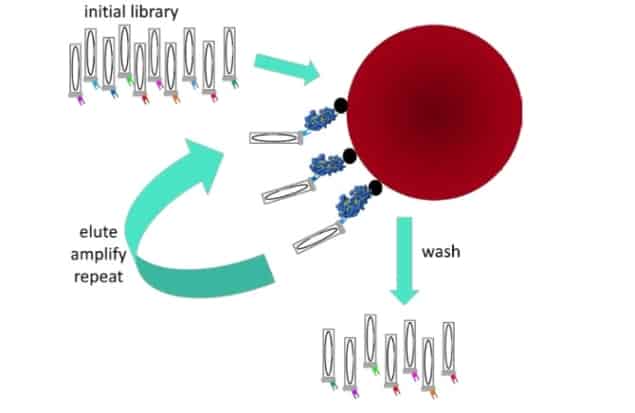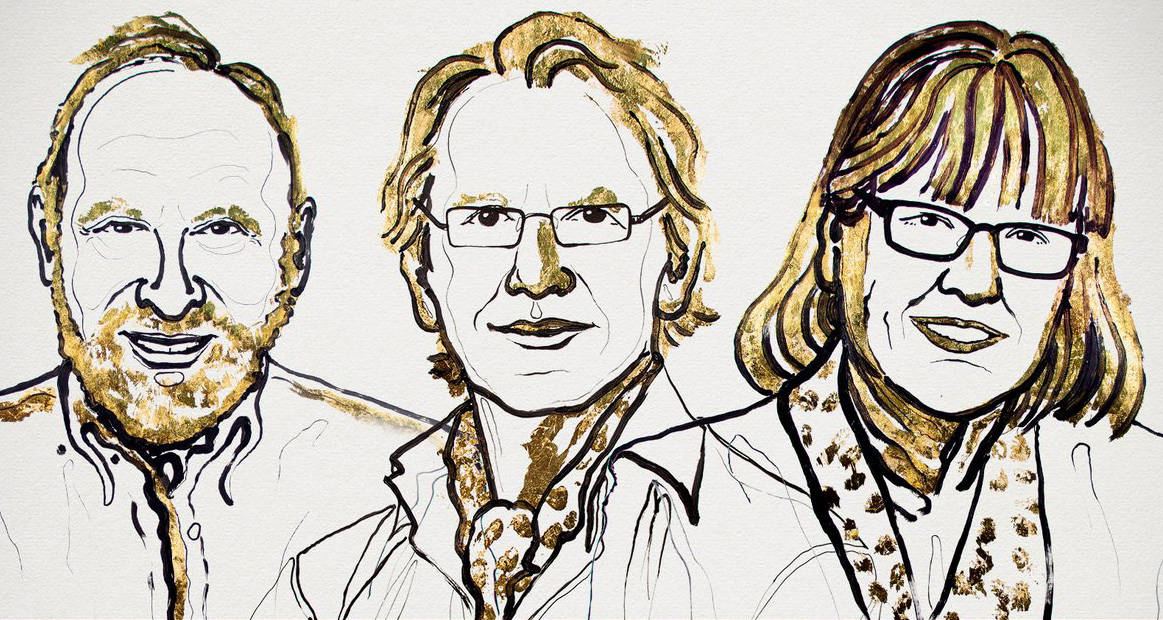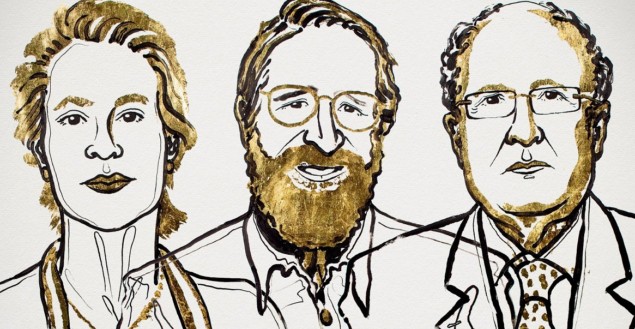Frances H Arnold, George P Smith and Gregory P Winter win the Nobel Prize for Chemistry
03 Oct 2018 Anna Demming
2018 Nobel Prize in Chemistry winners: Frances H Arnold, George P Smith and Gregory P Winter
The 2018 Nobel Prize for Chemistry has been awarded to Frances H Arnold, George P Smith and Gregory P Winter for “harnessing the power of evolution”. Arnold takes half the prize for “the directed evolution of enzymes”, which may be used to produce catalytic proteins that enable safer greener industrial chemistry for pharmaceuticals and green fuels. Smith and Winter take a quarter of the prize each for “the phage display of peptides and antibodies”, which may be used to produce human antibodies that may be used to neutralize toxins, counteract autoimmune diseases and treat metastatic cancer.
The 2018 Nobel Prize for Chemistry has been awarded to Frances H Arnold, George P Smith and Gregory P Winter for “harnessing the power of evolution”. Arnold takes half the prize for “the directed evolution of enzymes”, which may be used to produce catalytic proteins that enable safer greener industrial chemistry for pharmaceuticals and green fuels. Smith and Winter take a quarter of the prize each for “the phage display of peptides and antibodies”, which may be used to produce human antibodies that may be used to neutralize toxins, counteract autoimmune diseases and treat metastatic cancer.
Frances H. Arnold was born in Pittsburgh in the US in 1956 and completed her PhD at the University of California, Berkeley in 1985. She is currently the Linus Pauling Professor of Chemical Engineering, Bioengineering and Biochemistry, at the California Institute of Technology, Pasadena, USA.
George P. Smith was born in 1941 in Norwalk, in the US. He received a PhD in 1970 at Harvard University in the US, and is currently the Curators’ Distinguished Professor Emeritus of Biological Science at the University of Missouri in the US.
Sir Gregory P. Winter was born 1951 in Leicester, UK. He studied for his PhD at the University of Cambridge, UK, graduating in his doctorate in 1976. He remains at Cambridge as research Leader Emeritus, at the MRC Laboratory of Molecular Biology.

The work flow for the directed evolution of enzymes. Credit Nobel Foundation
Taking the reins in enzyme evolution
The directed evolution of enzymes takes its inspiration from the process nature uses to arrive at the panoply of proteins required for all the biological processes in a healthy, and evolutionarily competitive organism: genes that program better functioning organisms are more likely to survive and proliferate into the next generation than lesser performing prototypes. While for millennia farming and agriculture have intercepted the process with the selection and breeding of livestock and crops with features that are specifically desirable for human needs, directed evolution takes the process from the field to the lab and expedites it. This way refining a characteristic can take place over the course of a single experiment rather than several generations of breeding.
Manfred Eigen proposed an iterative algorithm for “Evolutionary molecular engineering based on RNA replication” in Pure Applied Chemistry in 1984. He suggested a procedure that began with production of a mutant spectrum of self-reproducing templates, followed by separation and cloning of individual mutants, amplifying and then expressing the clones, and then a test for optimal phenotypes and identification of optimal genotypes before the procedure is repeated to optimize an enzyme. Ten years later Arnold and her co-workers were able to demonstrate directed evolution of the enzyme subtilisin E to obtain a variant, which was active in unnatural conditions that would normally denature it, that is, high concentrations of the polar organic solvent dimethylformamide (DMF).
Practical implementation of directed enzyme evolution raises a series of challenges. Careful selection is needed for the initial enzyme to ensure that it has some low level of activity for the desired reaction, the DNA sequence library must cover the right subsets, the right selection criteria and the approach to make them more stringent between rounds are crucial, and the diversification to create new DNA sequences with new subsets – the component that introduces the controlled element of randomness that mimics evolution – must also perform on point.
Since their report of “Enzyme engineering for nonaqueous solvents” using directed evolution in 1991, Arnold’s lab and others around the world have published extensively on ways to improve on each step of the process of extended evolution. Arnold has also used directed evolution to demonstrate tolerance to two opposing extremes of conditions within the same catalyst, something that nature would usually cover in two separate enzymes, such as one for extreme heat and one for extreme cold. She and co-workers have also produced enzymes to catalyse reactions where no enzyme was previously available, including adjusting the activity of cytochrome P450 to catalyse the industrially significant reaction cyclopropanation.
The work bears an extensive legacy in pharmaceuticals where it is used in the production of a number of taste enhancers, drugs to tackle diabetes and vascular plaques and lower lipids. Application of directed evolution in mass-produced chemicals include detergents and biocatalysts, which have replaced some chemical catalysts to provide green alternatives for industrial synthesis, and work continues for catalysts in new fields such as protein synthesis.

Selection of high-affinity binding proteins from phage display libraries. Credit: Nobel Foundation
Manipulating phage display
A phage – also known as a bacteriophage – is a virus that infects and replicates inside bacteria. They encapsulate DNA. Certain proteins encoded by the DNA are presented on the surface of the phage, which has been used for screening. In 1985 Smith showed that he could change a peptide in one of these surface proteins and that the peptide would maintain interactions with its target antibodies. What is more he showed that the phages “displaying” the desired peptide could be enriched so that their concentrations were increased by a factor of 1000.
The work has led to directed evolution of binding proteins by physically coupling the phenotype (high affinity high selectivity binding protein) and genotype (DNA sequence). Smith’s insight also revealed the potential for exploiting phage display in vaccines. Because phage display can identify antigens, reversing the procedure has provided a route towards identifying new therapeutic antibodies.READ MORE

Phage fragment display
In 1990 Winter developed work on phage display to demonstrate a phage displaying a folded and fully functional antibody fragment. In the first demonstration Winter and co-workers displayed scFv derived in immunized mice against hen egg-white lysozyme in fusion with the filamentous phage protein III. The binding was so specific that while the scFv -phages bound to hen egg-white lysozyme, they would not bind to human or turkey egg-white lysozyme. The scientists attributed the very high specificity to the functional folded form of scFv displayed on the phage surface. They were able to achieve an enrichment in the phage carrying the antigen-binding fragment over other phages by a factor of a million in just two rounds of affinity purification with intervening amplification of the retained phages.
Phage display technology is now used in improved immunisations, the boosted antigen affinity it can achieve allows subcutaneous administration of drugs that would previously require intravenous injections at a doctor’s surgery. Clinically approved drugs derived from phage display include Adalimumab (2002) which binds to TNF -α , a pro-inflammatory cytokine, and is used to treat rheumatoid arthritis, psoriasis and inflammatory bowel disease, among other conditions.
Full details of the awards and recipients are available at the Nobel Foundation.

8/10/2018 FROM PHYSICSWORLD.COM

Δεν υπάρχουν σχόλια:
Δημοσίευση σχολίου